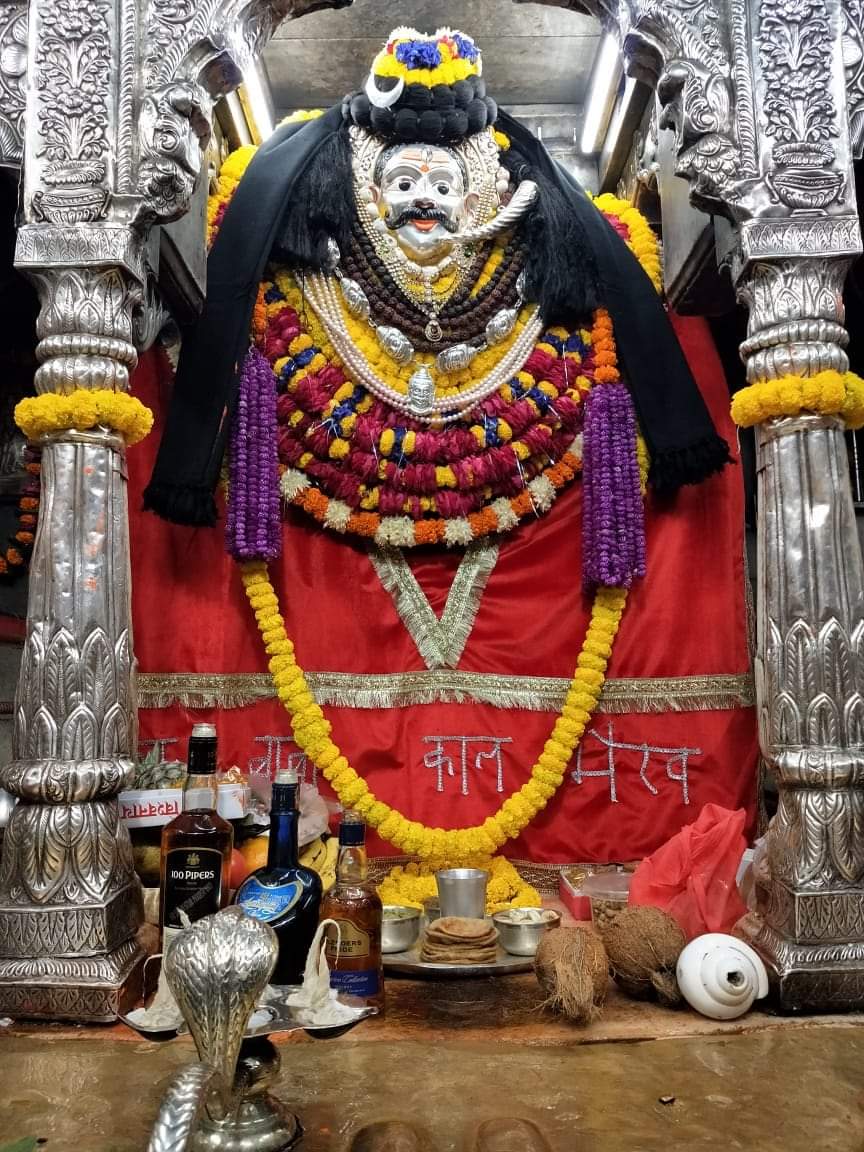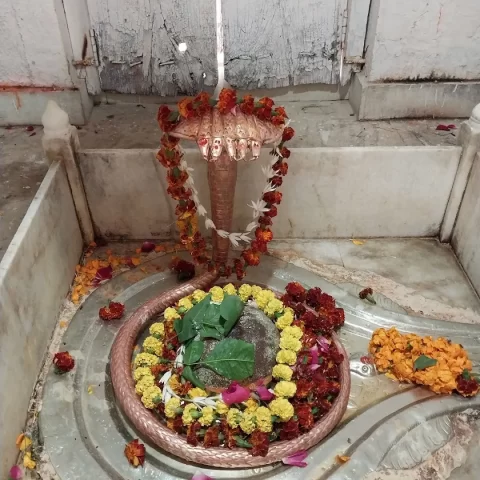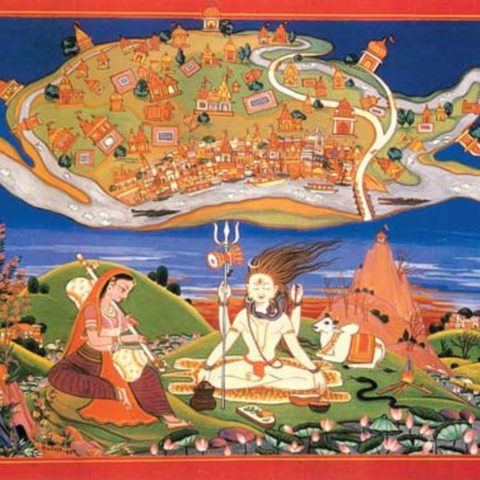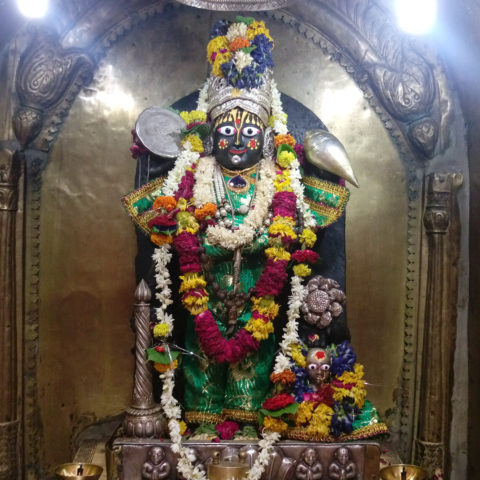
Kaal Bhairav Temple is one of the most important temples of Kashi. It is also one of the oldest temples of Varanasi. Kaal Bhairav Temple is always buzzing with incessant flow of devotees. There are ten temples of Kaal Bhairav in Kashi. Out of which the Kaal Bhairav Temple of Bharonath area is the prominent one.
Lord Kaal Bhairav guards the gates of Kashi. He is also known as the Kotwal (police chief) of Kashi. It is by his darshan only that devotee can reap the full benefit of Kashi Yatra. In fact the Kaal Bhairav was created from the anger of Lord Shiva.
“Kashi ke Kotwal – Kaal Bhairav”
Located in the Bharonath area of Vishweshwarganj in Varanasi, the Kaal Bhairav Temple is a must visit for devotees of Lord Vishwanath in Kashi. The current Kaal Bhairav temple was built in the 17th century after the old temple was destroyed during the invasion of the Islamic kings. It stands one kilometre away from the famous Kashi Vishwanath temple.
One who is a devotee of Lord Vishwanatha must visit Kaal Bhairav Temple to reap the full benefit of the pilgrimage. Lord Kaal Bhairav is depicted as one wearing a garland of skulls, holding a trident in his hand and with a dog as his career. He destroys or subdues the sins of his devotees. Hence, he is known as Papabhakshak. ‘Papa’ implies sins while ‘bhakshak’ implies eating.
The Kashi Khanda of the Skanda Purana says that a person can get rid of sins committed there or elsewhere simply by remembering the holy spot of Kapalamochana. It was at Kapalamochana that the skull of Lord Brahma fell from the hand of Lord Kaal Bhairav thus releasing him from the sin of brahma-hatya. Also, if one takes a holy bath in the Kapalamochana Teertha offering respects to the Gods and ancestors, he/she gets freedom from the sin of brahma-hatya.
The origin of Kaal Bhairav Temple
The Kashi Khanda of the Skanda Purana narrates the following lila about the establishment of the Kaal Bhairav temple in Kashi.
Once upon a time, the great sages gathered on the peak of Mount Meru for discussion on spiritual topics. They asked Lord Brahma who was present too as to what was the highest immutable principle. Lord Brahma answered that there was no truth bigger than himself. Immediately, Kratu, an amsha (part) of Lord Narayana spoke in anger that He was the ultimate goal of all activities.
In order to get acceptance, Lord Brahma and Kratu both turned to the four Vedas for their confirmation. The Vedas agreed to their request and thus the duo declared that the words of the Vedas shall be the authority. All the Vedas spoke in unison that Lord Shiva is the ultimate goal or principle in the universe.
Thus, on hearing this, Lord Brahma and Kratu asked as to how did Lord Shiva achieve that position. Very soon, Lord Shiva appeared in front of Lord Brahma and Kratu. Lord Brahma told Lord Shiva that he would accord protection to Lord Shiva if he would seek refuge in Lord Brahma. Hearing this, Lord Shiva, who was angry, created a form of terrifying appearance.
He said “O Kalabhairava, this Lotus-born deserves to be chastised by you. You shine like veritable Kala. Hence you are Kalaraja. You are capable of bearing the universe. You are known as Bhairava through your capability to bear the universe. Even Kala will be afraid of you. Hence you are Kalabhairava. Since you, on being enraged, will suppress the wicked-minded ones, you will earn reputation everywhere as Amardaka. Since you will be eating up the sins of your devotees within a moment, you will have the name of Papabhakshana (‘Devourer of sins’). O Kalaraja, forever you will have the over-lordship of Kashi which is mine, the city of liberation, greater than all others. You will be the sole one to admonish and chastise those who commit sins here. Citragupta will not be recording their auspicious or inauspicious activities.”
After receiving these boons from Lord Shiva, the terrifying looking Kaal Bhairav cut of the fifth head of Lord Brahma with the tip of the nail of his left hand. Lord Brahma had spoken those offensive words through the mouth of his fifth head. Seeing this, Kratu and Lord Brahma praised Lord Shiva who became very happy and instructed Kaal Bhairav to always respect Kratu and Lord Brahma.
Kaal Bhairav was asked to go about the universe abegging with the skull of Lord Brahma so as to destroy the sin of Brahma-hatya. Furthermore, Lord Shiva created a feminine form who represented Brahma-hatya. She was red in complexion, clad in red, had red garlands, scents and unguents. She had a hideous face with curved fang-like teeth. Her tongue was lolling and she was drinking blood. She had a knife and broken pot in her hand. Even Kaal Bhairav was terrified.
“Did you know that there are 10 temples of Kaal Bhairav one must visit in Kashi?”
Lord Shiva instructed her to follow Kaal Bhairav until he reaches Kashi. And that she would not have access to Kashi. Kaal Bhairav became black in complexion due to his proximity with brahma-hatya. Following the Kaapalikavrata, Kaal Bhairav started travelling all over the three worlds with the skull of Lord Brahma in his hand. Brahma-hatya didn’t leave him wherever he went.
Kaal Bhairav went to Vaikuntha, the abode of Lord Narayana. Lord Narayana along with all sages, demigods, etc who were present in Vaikuntha offered all respects to Kaal Bhairav. Lord Narayana turned towards His eternal consort Lakshmi Devi and glorified Kaal Bhairav. After doing so, Lord Narayana turned to Kaal Bhairav and asked him as to why he was going around the three worlds with a skull in his one hand and begging bowl in the other hand.
Kaal Bhairav replied that he had cut-off Lord Brahma’s head with the tip of his nail and hence, he was performing the penances required to remove the sin of brahma-hatya. Hearing this, Lord Vishnu further glorified Kaal Bhairav after which Lakshmi Devi offered sacred alms into his begging bowl. Following this, Kaal Bhairav left Vaikuntha.
“All the outgoing & incoming commissioners must pay a visit to him to seek his permission & blessings for overlooking Kashi affairs.”
Lord Narayana requested brahma-hatya to leave Kaal Bhairav but she refused as she desired to purify herself in Kaal Bhairav’s company. Kaal Bhairav thus left Vaikuntha and wandered around in the three worlds until he reached Kashi. As he entered Kashi, brahma-hatya became terrified by his form and screamed in despair. She fell into the lower worlds called Patalaloka.
The skull of Lord Brahma fell down immediately from Kaal Bhairav’s hand while people watched on. He danced in jubilation on seeing this. Thereafter, Kaal Bhairav stood at the holy spot of Kapalamochana in Kashi to eat up the sins of devotees who take shelter of him. The same site is now revered as the Kaal Bhairav Temple.
Temple Timings of Kaal Bhairav Temple
Lord Kaal Bhairav is present in the temple sanctum sanctorum as a silver-faced Deity who holds a trident and sits on a dog. Devotees can only see the face of Lord Kaal Bhairav through the doorway. The remaining part of the Deity is covered by a cloth. The Deity sits in a building situated in the middle of a beautiful courtyard protected by the main wall.
You can have the darshan of Lord Kaal Bhairav in the temple at the following time:
Morning: 5.00 AM to 1.30 PM
Evening: 4.30 PM to 9.30 PM
The timings will vary during important festivals and occasions.
Festivals of Kaal Bhairav temple
Bhairav-ashtami and Shivaratri are the most important festivals at the Kaal Bhairav temple. Bhairav-ashtami celebrates the appearance of Kaal Bhairav on the Krishna paksha Ashtami of the Margashirsha (Dec-Jan) month. The temple will be heavily crowded on this festive occasion. Shivaratri too witnesses huge crowds and pompous decorations. Annakuta festival is also celebrated at the Kaal Bhairav Temple.
How to reach Kaal Bhairav Temple
Lord Kaal Bhairav was appointed as the guardian of Kashi by Lord Shiva. Hence, it is important that you visit Kaal Bhairav Temple to take his permission and blessings before commencing the Kashi Yatra including darshan at Kashi Vishwanath temple. The same applies even if you intend to do pind-daan at Kashi.
Reaching Kashi is the first step towards visiting the Kaal Bhairav temple. Once in Kashi, you have local transportation options such as Rickshaws, etc to reach the Kaal Bhairav temple. If you choose to travel with Tirtha Yatra on their Kashi Yatra or Ayodhya-Kashi Yatra, you don’t have to worry about anything.
You can choose the following ways to reach Kashi:
By Road: Kashi is well connected by road to major cities in India such as New Delhi, Mumbai, Lucknow, etc. You can travel in a private vehicle from other cities or hire a taxi. Luxury buses and normal buses are available from Lucknow frequently.
By Rail: Kashi is very well connected to major cities and towns in India via the five railway stations i.e., Kashi Railway Station, Varanasi Junction (also called Varanasi Cantt), Varanasi City, Banaras Railway Station and Pt. Deen Dayal Upadhyaya Junction. Tickets can be reserved up-to any one of these five stations.
By Air: Kashi is accessible by air through the Lal Bahadur Shastri Airport at Babatpur near Kashi. Domestic and International flights are available from and to the airport. From there, you can take a prepaid taxi to reach the city centre
1













Comment On Kaal Bhairav Temple, Kashi
i want best photo